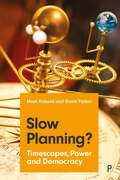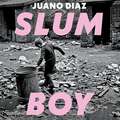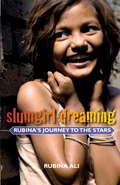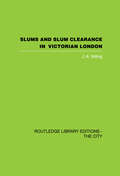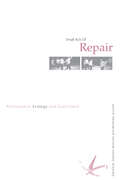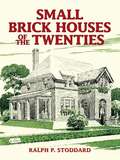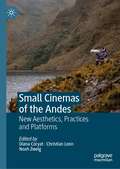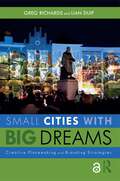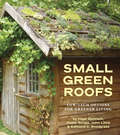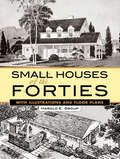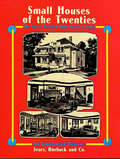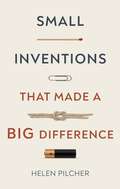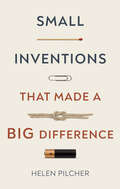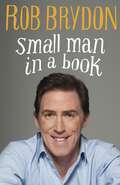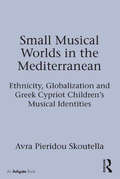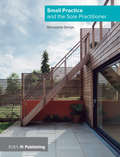- Table View
- List View
Slow Planning?: Timescapes, Power and Democracy
by Gavin Parker Mark DobsonA deep exploration on how questions of time and its organisation affect planning practice, this book questions ‘project speed’: where time to think, deliberate and plan has been squeezed. The authors demonstrate the many benefits of slow planning for the key participants, multiple interests and planning system overall.
Slow Print: Literary Radicalism and Late Victorian Print Culture
by Elizabeth Carolyn MillerThis book explores the literary culture of Britain's radical press from 1880 to 1910, a time that saw a flourishing of radical political activity as well as the emergence of a mass print industry. While Enlightenment radicals and their heirs had seen free print as an agent of revolutionary transformation, socialist, anarchist and other radicals of this later period suspected that a mass public could not exist outside the capitalist system. In response, they purposely reduced the scale of print by appealing to a small, counter-cultural audience. "Slow print," like "slow food" today, actively resisted industrial production and the commercialization of new domains of life. Drawing on under-studied periodicals and archives, this book uncovers a largely forgotten literary-political context. It looks at the extensive debate within the radical press over how to situate radical values within an evolving media ecology, debates that engaged some of the most famous writers of the era (William Morris and George Bernard Shaw), a host of lesser-known figures (theosophical socialist and birth control reformer Annie Besant, gay rights pioneer Edward Carpenter, and proto-modernist editor Alfred Orage), and countless anonymous others.
Slugfest: Inside the Epic, 50-year Battle between Marvel and DC
by Reed TuckerThe first in-depth, behind the scenes book treatment of the rivalry between the two comic book giants.THEY ARE THE TWO TITANS OF THE COMIC BOOK INDUSTRY--the Coke and Pepsi of superheroes--and for more than 50 years, Marvel and DC have been locked in an epic battle for spandex supremacy. At stake is not just sales, but cultural relevancy and the hearts of millions of fans.To many partisans, Marvel is now on top. But for much of the early 20th century, it was DC that was the undisputed leader, having launched the American superhero genre with the 1938 publication of Joe Shuster and Jerry Siegel's Superman strip. DC's titles sold millions of copies every year, and its iconic characters were familiar to nearly everyone in America. Superman, Batman, Wonder Woman--DC had them all.And then in 1961, an upstart company came out of nowhere to smack mighty DC in the chops. With the publication of Fantastic Four #1, Marvel changed the way superheroes stories were done. Writer-editor Stan Lee, artists Jack Kirby, and the talented Marvel bullpen subsequently unleashed a string of dazzling new creations, including the Avengers, Hulk, Spider-Man, the X-Men, and Iron Man.Marvel's rise forever split fandom into two opposing tribes. Suddenly the most telling question you could ask a superhero lover became "Marvel or DC?"Slugfest, the first book to chronicle the history of this epic rivalry into a single, in-depth narrative, is the story of the greatest corporate rivalry never told. Complete with interviews with the major names in the industry, Slugfest reveals the arsenal of schemes the two companies have employed in their attempts to outmaneuver the competition, whether it be stealing ideas, poaching employees, planting spies, or launching price wars. The feud has never completely disappeared, and it simmers on a low boil to this day. With DC and Marvel characters becoming global icons worth billions, if anything, the stakes are higher now than ever before.
Slum Boy: A Portrait
by Juano DiazOne of the most moving accounts of non fiction ever written according to the Guardian 'This is a heart-breaking story, beautifully told. I hope it finds a million readers' - Andrew O'Hagan'What a brave and powerful story. If you like Shuggie Bain and Damian Barr then Slumboy is for you' - Lemn Sissay'Compulsively readable, it's Dickensian in its rich cast of Glaswegian characters' - Patrick GaleJohn MacDonald must find his mother. Born into the slums of Glasgow in the late '70s, a 4-year-old John's life is filled with the debris of alcoholism and poverty. Soon after witnessing a drowning, his mother's addictions take over their lives, leaving him starving in their flat, awaiting her return.A concerned neighbor reports her, and he is forcibly taken away from his mother and placed into the care system. There, he dreams of being reunited with her. His mind is consumed with images and memories he can't process or understand, which his eventual adoptive parents silence out of fear as he grows into a young man within a strict Catholic and Romany Gypsy community.This memoir is about how John found his way to his true identity, Juano Diaz, and how, against all odds, his unstoppable love for his mother sets him free.
Slumgirl Dreaming: Rubina's Journey to the Stars
by Rubina AliMy name is Rubina Ali. I don't know when my birthday is, and nor does my father, but I do know that I am nine years old. Young Rubina is a one-in-a-million star. Plucked from among five hundred slumkids who auditioned for Danny Boyle's multi-Oscar-winning filmSlumdog Millionaire,she saw her fairy-tale dream of stardom come true. Now that she has stepped into the limelight, what will life hold for a young girl from the Mumbai slums? Rubina tells her own incredible story, bringing to life a world of wastelands and rat-infested shanty dwellings, where she played marbles with her friends beside the sewers of Garib Nagar. She introduces her beloved father, a hardworking rickshaw puller, and her siblings. And then Rubina tells of the kindness of Danny Boyle and of the time she spent on the film sets--including the hilarious incident when her costar came to be covered in chocolate from head to toe. After her brief encounter with red-carpet glamour, how will Rubina come to terms with the conditions in which she, her family, and her friends continue to live since Hollywood came knocking? This is her compelling story.
Slytod: Diana Thorneycroft
by Diana ThorneycroftThis catalogue grew out the slytod exhibition at Gallery 1. 1. 1. from 19 October until 14 November 1997 by Diana Thorneycroft. The catalogue includes 20 of Thorneycroft’s silver prints, an Introduction by Serena Keshavjee, and essays by Martha Langford and Chris Townsend.
Smack Dab in the Middle of Maybe
by Jo Watson HacklA Mississippi ghost town and an art mystery combine in this gorgeously written debut just right for fans of Three Times Lucky and A Snicker of Magic!How far would you go to find something that might not even exist?All her life, Cricket's mama has told her stories about a secret room painted by a mysterious artist. Now Mama's run off, and Cricket thinks the room might be the answer to getting her to come back. If it exists. And if she can find it.Cricket's only clue is a coin from a grown-over ghost town in the woods. So with her daddy's old guidebook and a coat full of snacks stolen from the Cash 'n' Carry, Cricket runs away to find the room. Surviving in the woods isn't easy. While Cricket camps out in an old tree house and looks for clues, she meets the last resident of the ghost town, encounters a poetry-loving dog (who just might hold a key to part of the puzzle), and discovers that sometimes you have to get a little lost . . . to really find your way.* "Told in the easy, laconic tone of good, Southern storytelling, Hackl's debut rolls off the tongue and into the heart easy as warm butter on a biscuit. Lyrical and endearing, this debut is a genuine adventure tale."--Kirkus Reviews, Starred Review"A tale of adventure, full of mystery." --Robert Beatty, #1 New York Times bestselling author of Serafina and the Black Cloak"Smack Dab in the Middle of Maybe is part treasure hunt, part wilderness adventure, and all heart."--Alan Gratz, New York Times Bestselling author of Refugee"A heartwarming coming-of-age story." --Kirby Larson, Newbery Honor-winning author of Hattie Big Sky"A masterful debut. Cricket is my new hero, brave and funny and full of heart. I couldn't put it down."--Augusta Scattergood, author of Glory Be"A brilliant, utterly absorbing debut. I couldn't get enough of Cricket's adventures. Totally unputdownable."--Carrie Ryan, New York TImes Bestselling author of The Forest of Hands and Teeth
Small Acts of Repair: Performance, Ecology and Goat Island
by Stephen Bottoms Matthew GoulishGoat Island are one of the world’s leading contemporary performance ensembles. Their intimate, low-tech, intensely physical performances represent a unique hybrid of strategies and techniques drawn from live art, experimental theatre and postmodern dance. Small Acts of Repair: Performance, Ecology and Goat Island, is the first book to document and critique the company’s performances, processes, politics, aesthetics, and philosophies. It reflects on the company’s work through the critical lens of ecology – an emerging and urgent concern in performance studies and elsewhere. This collage text combines and juxtaposes writing by company members and arts commentators, to look in detail at Goat Island’s distinctive collaborative processes and the reception of their work in performance. The book includes a section of practical workshop exercises and thoughts on teaching drawn from the company’s extensive experience, providing an invaluable classroom resource. By documenting the creative processes of this extraordinary company, this book will make an important contribution to the critical debates surrounding contemporary performance practices. In so doing, it pays compelling tribute to committed art-making, creativity, collaboration, and the nature of the possible.
Small Brick Houses of the Twenties
by Ralph P. StoddardOnce affordable only among the wealthy, brick homes became more easily available to the average American in the early years of the twentieth century. This book, originally published in 1920 by a member of The Common Brick Manufacturers' Association, served as a practical guide for prospective homeowners from working class families. Many soon found that attractive, durable, and comfortable homes--made from nature's own building material--were easily within their financial reach. <p><p> Thirty-five sets of floor plans, elevations, and specifications in this excellent reproduction of that now-rare volume depict a wide variety of brick houses, bungalows, cottages, garages, and multi-dwelling buildings--from the four-bedroom Pocatello to the handsome Saratoga, featuring a wraparound porch and two bathrooms. This practical guide will appeal to anyone wanting to buy or renovate an existing home of the period. It will also serve as a how-to manual for all desiring to build their own homes today with authentic materials and techniques. For those who love fine, old buildings, Small Brick Houses of the Twenties offers a charming view of American homes from that era.
Small Change: About the Art of Practice and the Limits of Planning in Cities
by Nabeel HamdiWhat exactly is 'small change'? Build a bus stop in an urban slum and a vibrant community sprouts and grows around it - that is the power of small changes that have huge positive effects. This book is an argument for the wisdom of the street, the ingenuity of the improvisers and the long-term, large-scale effectiveness of immediate, small-scale actions. Written by Nabeel Hamdi, the guru of urban participatory development and the master of the art, Small Change brings over three decades of experience and knowledge to bear on the question 'what is practice'?. Through an easy-to-read narrative style, and using examples from the North and South, the author sheds light on this question and the issues that stem from it - issues relating to political context, the lessons of the 'informal city', and the pursuit of learning that challenges convention. The result is a comprehensive, yet imaginative, guide to the forms of knowledge, competencies and ways of thinking that are fundamental to skilful practice in urban development. This is powerful, informed, critical and inspiring reading for practitioners in the field, students and teachers of urban development, those who manage international aid and everyone looking to build their community.
Small Cinemas of the Andes: New Aesthetics, Practices and Platforms
by Diana Coryat Christian León Noah ZweigThis book examines the emergence of small cinemas of the Andes, covering digital peripheries in Ecuador, Bolivia, Peru and Colombia. The volume critically assesses heterogeneous audiovisual practices and subaltern agents, elucidating existing tensions, contradictions and resistances with respect to established cinematic norms. The reason these small cinematic sectors are of interest is twofold: first, the film markets of the aforementioned countries are often eclipsed by the filmmaking giants of Mexico, Brazil and Argentina; second, within the Andean countries these small cinemas are overshadowed by film board-backed cinemas whose products are largely designed for international film festivals.
Small Cities with Big Dreams: Creative Placemaking and Branding Strategies
by Greg Richards Lian DuifHow can small cities make an impact in a globalizing world dominated by ‘world cities’ and urban development strategies aimed at increasing agglomeration? This book addresses the challenges of smaller cities trying to put themselves on the map, attract resources and initiate development. Placemaking has become an important tool for driving urban development that is sensitive to the needs of communities. This volume examines the development of creative placemaking practices that can help to link small cities to external networks, stimulate collaboration and help them make the most of the opportunities presented by the knowledge economy. The authors argue that the adoption of more strategic, holistic placemaking strategies that engage all stakeholders can be a successful alternative to copying bigger places. Drawing on a range of examples from around the world, they analyse small city development strategies and identify key success factors. This book focuses on the case of ‘s-Hertogenbosch, a small Dutch city that used cultural programming to link itself to global networks and stimulate economic, cultural, social and creative development. It advocates the use of cultural programming strategies as a more flexible alternative to traditional top-down planning approaches and as a means of avoiding copying the big city. The Open Access version of this book, available at http://www.taylorfrancis.com, has been made available under a Creative Commons Attribution-Non Commercial-No Derivatives (CC-BY-NC-ND) 4.0 license.
Small Cities: Urban Experience Beyond the Metropolis (Questioning Cities)
by David Bell Mark JayneUntil now, much research in the field of urban planning and change has focused on the economic, political, social, cultural and spatial transformations of global cities and larger metropolitan areas. In this topical new volume, David Bell and Mark Jayne redress this balance, focusing on urban change within small cities around the world. Drawing together research from a strong international team of contributors, this four part book is the first systematic overview of small cities. A comprehensive and integrated primer with coverage of all key topics, it takes a multi-disciplinary approach to an important contemporary urban phenomenon. The book addresses: political and economic decision making urban economic development and competitive advantage cultural infrastructure and planning in the regeneration of small cities identities, lifestyles and ways in which different groups interact in small cities. Centering on urban change as opposed to pure ethnographic description, the book’s focus on informed empirical research raises many important issues. Its blend of conceptual chapters and theoretically directed case studies provides an excellent resource for a broad spectrum of undergraduate and postgraduate students, as well as providing a rich resource for academics and researchers.
Small Green Roofs: Low-Tech Options for Greener Living
by John Little Edmund C. Snodgrass Nigel Dunnett Dusty GedgeUntil now, the green roof movement has been limited to large-scale, professional endeavors and public buildings. But homeowners everywhere are catching onto the benefits of a green roof—water conservation, energy savings, and storm water management. In Small Green Roofs authors Dunnett, Gedge, Little, and Snodgrass profile ordinary homeowners who scaled green roofs down to the domestic level.Small Green Roofs is the first book to focus on small-scale and domestic green roofs. More than forty profiles of small and domestic-scale projects of all shapes and sizes include green roofs on sheds, garden offices, studios, garages, houses, bicycle sheds, and other small structures, as well as several community projects. For each project, details are given for design, construction, and installation, as well as how-to tips on how the roof was planted and cared for. For readers looking for inspiration when hiring a contractor or taking the adventurous step of building their own, Small Green Roofs provides the knowledge and encouragement to make it possible.
Small Houses of the Forties: With Illustrations and Floor Plans
by Harold E. GroupDesigned for the 1940s family with a "limited budget but unlimited good taste," this fascinating volume presents 56 floor plans and elevations of lovely small homes that originally cost less than $15,000 to build. Each home, bearing the honorable designation of House-of-the-Month by the era's Monthly Small House Club, Inc., was designed to give prospective homeowners an exceptionally well-planned house that was also a sound investment. From Cape Cods to Colonials, Small Houses of the Forties offers an eden of illustrations of cozy, charming domiciles, complete with color combinations, charts, and diagrams. This complete republication of a now-rare volume is also filled with vintage dollars-and-sense information for the postwar homebuyer, including mortgage guidance, amortization schedules, valuations, and construction costs of the times. <p><p> A nostalgic flashback to a simpler American dream of white picket fences, this entertaining and valuable reference will delight architecture enthusiasts, plan collectors, restorers, and historians alike.
Small Houses of the Twenties: The Sears, Roebuck 1926 House Catalog
by Co. Sears RoebuckFor almost 20 years, Sears, Roebuck and Company purveyed the materials for complete prefabricated houses, providing thousands of Americans with attractive and comfortable low-cost dwellings. Many of these homes are still a common feature in cities and towns across America.The present volume, a meticulous reproduction of a rare Sears, Roebuck catalog of 1926, provides a thorough, accurate record of the company's "Honor Bilt Modern Homes." Over 300 photographs and illustrations, with full descriptions, offer views of 86 different houses and cottages of widely varying sizes and designs. Readers may recognize familiar architectural styles in designs such as the cozy six-room "Homewood" bungalow or the elegant "Lexington," a nine-room, green-shuttered colonial. Also shown are several room interiors for each of 14 homes, along with photographs and plans for nine garages and a hunter's cabin. In addition to visual documentation, the catalog provides extensive, detailed construction information, ranging from the grade of exterior siding to the type of wood used for flooring, windows, and trim.An invaluable primary source illustrated for anyone engaged in the study, authentication, or restoration of antique homes or furnishings, this period catalog will also be of special value to architectural and social historians, Americana enthusiasts, and general readers.
Small Inventions That Made a Big Difference: From Prehistory To The Present
by Helen PilcherPockets, matches, spectacles, postage stamps. Whether it's the stitches that hold our clothes together or the syringes that deliver life-saving vaccines, small things really do make a big difference. Yet these modest but essential components of everyday life are often overlooked.Science and comedy writer Helen Pilcher shares the unexpected stories of 50 humble innovations – from the accidental soldering of two bits of metal that created the pacemaker, to the eighteenth-century sea captain whose ingenious invention paved the way for the filming of Star Wars – and celebrates the joy of the small yet mighty.
Small Inventions That Made a Big Difference: From Prehistory To The Present
by Helen PilcherPockets, matches, spectacles, postage stamps.Whether it's the stitches that hold our clothes together or the syringes that deliver life-saving vaccines, small things really do make a big difference. Yet these modest but essential components of everyday life are often overlooked. Science and comedy writer Helen Pilcher shares the unexpected stories of 50 humble innovations - from the accidental soldering of two bits of metal that created the pacemaker, to the eighteenth-century sea captain whose ingenious invention paved the way for the filming of Star Wars - and celebrates the joy of the small yet mighty.
Small Inventions That Made a Big Difference: From Prehistory To The Present
by Helen PilcherPockets, matches, spectacles, postage stamps.Whether it's the stitches that hold our clothes together or the syringes that deliver life-saving vaccines, small things really do make a big difference. Yet these modest but essential components of everyday life are often overlooked. Science and comedy writer Helen Pilcher shares the unexpected stories of 50 humble innovations - from the accidental soldering of two bits of metal that created the pacemaker, to the eighteenth-century sea captain whose ingenious invention paved the way for the filming of Star Wars - and celebrates the joy of the small yet mighty.
Small Man in a Book
by Rob BrydonRob Brydon tells story of his slow ascent to fame and fortune in Small Man in a Book.A multi-award-winning actor, writer, comedian and presenter known for his warmth, humour and inspired impressions, Rob Brydon has quickly become one of our very favourite entertainers. But there was a time when it looked like all we'd hear of Rob was his gifted voice.Growing up in South Wales, Rob had a passion for radio and soon the Welsh airwaves resounded to his hearty burr. However, these were followed by years of misadventure and struggle, before, in the TV series Marion and Geoff and Gavin and Stacey, Rob at last tickled the nation's funny bone. The rest, as they say, is history. Or in his case autobiography.Small Man in a Book is Rob Brydon's funny, heartfelt, honest, sometimes sad, but mainly funny, memoir of how a young man from Wales very, very slowly became an overnight success.Rob Brydon was brought up in Wales, where his career began on radio and as a voiceover artist. After a brief stint working for the Home Shopping Network he co-wrote and performed in his breakthrough show, the darkly funny Human Remains. He has since starred in the immensely popular Gavin and Stacey, Steve Coogan's partner in The Trip, and was the host of Would I Lie to You? and The Rob Brydon Show. He now lives in London with his wife and five children.
Small Musical Worlds in the Mediterranean: Ethnicity, Globalization and Greek Cypriot Children's Musical Identities
by Avra Pieridou SkoutellaSmall Musical Worlds in the Mediterranean is a pioneering book-length study of the complex topics of identity, ethnicity and global processes in children’s musical lives in the Republic of Cyprus - a Mediterranean country during its post-colonial era. What is it about this country’s musical enculturation that made musical identity such a potent element in Greek Cypriot children’s worlds? How is history, tradition, modernity, ethnic fluidity, syncretism and diversification in the Mediterranean negotiated in the construction of musical ’self’ and ’other’ in children’s daily lives? This book, through a journey of ’fieldwork at home’, discusses how children select, reject, reproduce and transform meanings and create new ones at the micro-level of their lives through which individuals and groups define themselves and others. Towards this exploration, musical identity in childhood is discussed in terms of cultural production and reproduction, human expression, inter-relating and learning. Ethnographic vignettes of children’s musical practices and direct words add depth and humour to the flow of the book. This study is a synthesis of ethnomusicology, musical anthropology, education and folklore in which the author effectively weaves together theories of musical enculturation and identity, sociocultural learning and human agency. The book will be invaluable to scholars interested in musical enculturation, musical identities, children’s contextual musical practices, ethnicity, globalization studies, music education and Mediterranean studies.
Small Pleasures: Longlisted for the Women's Prize for Fiction
by Clare ChambersLONGLISTED FOR THE WOMEN'S PRIZE FOR FICTIONA BBC 2 'BETWEEN THE COVERS' BOOK CLUB PICK'Wonderful' RICHARD OSMAN'Perfect' INDIA KNIGHT'Beautiful' JESSIE BURTON'Witty and sharp' DAVID NICHOLLS1957, the suburbs of south east London. Jean Swinney is a journalist on a local paper, trapped in a life of duty and disappointment from which there is no likelihood of escape. When a young woman, Gretchen Tilbury, contacts the paper to claim that her daughter is the result of a virgin birth, it is down to Jean to discover whether she is a miracle or a fraud. As the investigation turns her quiet life inside out, Jean is suddenly given an unexpected chance at friendship, love and - possibly - happiness.'Gorgeous . . . I could not recommend it more' PANDORA SYKES'Remarkable . . . Small Pleasures is no small pleasure' THE TIMES'Irresistible . . . wry, perceptive and quietly devastating' MAIL ON SUNDAY
Small Practice and the Sole Practitioner
by Marianne Davys Architects LtdThis book is a practical guide for students or those already running or thinking of running a small practice on how to set up and run a small architectural practice and how to run multiple small projects efficiently. It is split into three distinct sections: Part 1 begins with the practicalities of setting up a small architectural business; Part 2 goes into detail on how to run your small practice, including valuable advice on business planning and cash flow; and Part 3 follows with guidance on running multiple small projects. Structured around the RIBA Plan of Work, this section has plenty of examples of the kinds of projects - both domestic and non-domestic - that the small practice might take on, and finishing with 10 illustrated case studies of domestic and commercial projects from £50,000–£750,000.
Small Projects Handbook
by Nigel OstimeThis hands-on, no-nonsense guide to running smaller projects – most under £250,000 in value – will become your 'bible' in day-to-day practice. Smaller practices often find it hard to turn a profit as they spend too much time and money, especially on the design stages, trying to compete and are unsure as to what they can safely dispense with whilst still being rigorous and delivering quality. This book provides reassurance as to how to achieve great results on a budget, utilising stripped-back and efficient solutions, while following the principles and stages of the RIBA Plan of Work. Each chapter provides: simple step-by-step guidance to the key tasks in that stage of the Plan of Work including inputs, outputs, stage activities and sustainability checkpoints in-text features which break down complex tasks and highlight best practice with pragmatic, real world advice including 'tips', 'warnings' and guidance on forms and templates inspiring case studies of small projects that document the architect's experience of the process guidance at each Plan of Work stage on the relevant practice issues that will help you to run your small project more effectively. Designed as a project handbook for smaller and medium sized architectural practices, it is also invaluable for Part 3 students getting to grips with how projects are run within the RIBA Plan of Work framework. Everybody in the project team – including clients, contractors and consultants – will find this a handy guide to the project process, full of useful insights and solutions.
